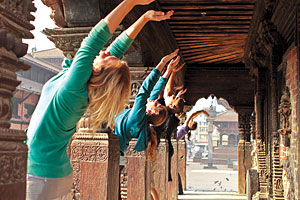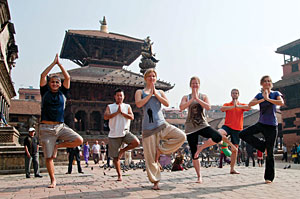 |
Yoga in recent decades has undergone a western facelift or perhaps more fittingly a reduction. Avid practitioners of the discipline are less likely to be full-fledged yogis on an ascetic quest to moksha (liberation from worldly suffering) and more likely to be well-to-do urban women.
"They say there are 15 million people practicing yoga in Europe and the US, but I wouldn't say there are 15 million yogis," explains Sam Voolstra, director of Pranamaya Yoga at the Moksh complex in Pulchowk.
The newly opened yoga center joins a list of studios available in Kathmandu, but its fresh, modern look contrasts with its typical ashram counterparts. Voolstra, a partner of the successful adventure sporting company The Last Resort, brings a similar approach to Pranamaya: a streamlined, frill-free brand with program options tailored to the customer's requirements.
"There is no such thing as one style of yoga," says Voolstra.
The center offers a set of diverse styles at varied levels of difficulty, including pregnancy, post-natal and children's yoga. It hopes to appeal to a wider demographic that would otherwise be repelled by yoga's religious connotation.
Pranamaya teams up experienced instructors from Europe, Nepal and North America. Yogatara (Lisa Alessandra) is a French American, who has lived in Nepal for 15 years and studied yoga at Bihar University, and Nadia Turgeon is a French Canadian who has been practicing Hatha yoga for 11 years and teaching for two. Both instructors are trained therapists and counselors who prescribe yoga as an alternative medicine.
 |
As a Western import modeled after Hatha yoga of the late Hindu revivalism in the 19th century, yoga popularised as an alternative workout centered on its health benefits.
"So when yoga went to the West and stepped out of the spiritual context, it was almost necessary for it to be understood as separate practice from religion," says Yogatara.
Ironically, as a consumable product imported from the West back to South Asia, yoga strips away the dogma rooted in the yoga sutras of Patanjali, practised by Hindu monist schools.
On the surface, a cultural typing emerges with this exchange. Layered apparel in muted, earth tones and a vernacular which echoes in eco-conscious and organic fads, shape a trademark lifestyle. Beneath, however, the foundation of postures (asanas), breathing (pranamaya), and relaxation (savasanas) remains.
In a beginner's Asthanga (Power) yoga class at Pranamaya, teacher Karina Skjelmose guides novices, mostly expat women, through basic forms, holding and controlling breathing techniques. Her instruction is professional, informative and strict to K Patabhi Jois's original teachings of Asthanga.
Drop-in classes are priced at Rs 600, and package deals are available. Two-day retreats at Rs 12,000 make for a pricey weekend workout. And to accommodate communities across the city, Pranamaya will conduct classes starting 1 July at a second branch at 1905 in Kantipath.
Says Yogatara: "Yoga is a very practical science and tool that can take people to a spiritual path, but not necessarily. Through their breathing and postures, they might discover something else, but that's their choice."
Read also:
Li Na represents not just China, but Asia, CLARENCE CHUA in BEIJING
First Asian woman to win a grand slam singles title prepares for Wimbledon
See also:
It's all in the mind, SHREYA MUKHERJEE


